MAZDA MODEL TRIBUTE 2008 Owners Manual (in English)
Manufacturer: MAZDA, Model Year: 2008, Model line: MODEL TRIBUTE, Model: MAZDA MODEL TRIBUTE 2008Pages: 288, PDF Size: 3.9 MB
Page 171 of 288
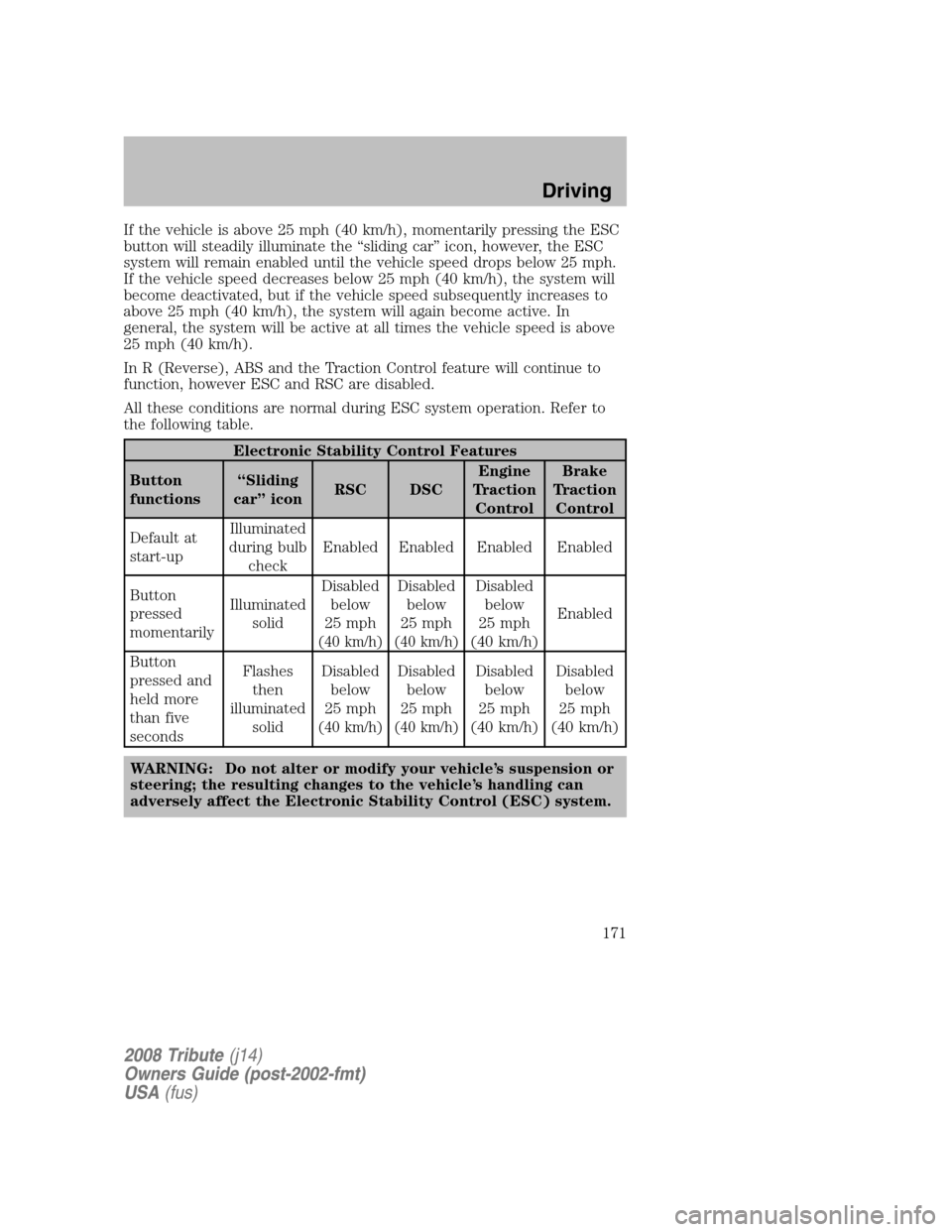
If the vehicle is above 25 mph (40 km/h), momentarily pressing the ESC
button will steadily illuminate the “sliding car” icon, however, the ESC
system will remain enabled until the vehicle speed drops below 25 mph.
If the vehicle speed decreases below 25 mph (40 km/h), the system will
become deactivated, but if the vehicle speed subsequently increases to
above 25 mph (40 km/h), the system will again become active. In
general, the system will be active at all times the vehicle speed is above
25 mph (40 km/h).
In R (Reverse), ABS and the Traction Control feature will continue to
function, however ESC and RSC are disabled.
All these conditions are normal during ESC system operation. Refer to
the following table.
Electronic Stability Control Features
Button
functions “Sliding
car” icon RSC DSC Engine
Traction Control Brake
Traction Control
Default at
start-up Illuminated
during bulb check Enabled Enabled Enabled Enabled
Button
pressed
momentarily Illuminated
solid Disabled
below
25 mph
(40 km/h)
Disabled below
25 mph
(40 km/h)
Disabled below
25 mph
(40 km/h) Enabled
Button
pressed and
held more
than five
seconds Flashes
then
illuminated solid Disabled
below
25 mph
(40 km/h)
Disabled below
25 mph
(40 km/h)
Disabled below
25 mph
(40 km/h) Disabled
below
25 mph
(40 km/h)
WARNING: Do not alter or modify your vehicle’s suspension or
steering; the resulting changes to the vehicle’s handling can
adversely affect the Electronic Stability Control (ESC) system.
2008 Tribute (j14)
Owners Guide (post-2002-fmt)
USA (fus)
Driving
171
Page 172 of 288

WARNING: Aggressive driving in any road conditions can cause
you to lose control of your vehicle increasing the risk of severe
personal injury or property damage. The occurrence of a
Electronic Stability Control (ESC) event is an indication that
at least some of the tires have exceeded their ability to grip the
road; this may lead to an increased risk of loss of vehicle
control, vehicle rollover, personal injury and death. If you
experience a severe road event, SLOW DOWN.
If a failure is detected in the ESC system, and the ESC button has not
been pushed, the warning indicator light in the instrument cluster will
stay on. If the warning indicator light in the instrument cluster remains
on while the engine is running, have the system serviced by an
authorized dealer immediately.
STEERING
Your vehicle is equipped with an Electric Power-Assisted Steering
(EPAS) system. There is no fluid reservoir to check or fill.
If your vehicle loses electrical power while you are driving (or if the
ignition is turned off), you can steer the vehicle manually, but it takes
more effort. Under extreme usage conditions, the steering effort may
increase. This occurs to prevent overheating and permanent damage to
your steering system. If this should occur, you will neither lose the ability
to steer the vehicle manually nor will it cause permanent damage.
Typical steering and driving maneuvers will allow the system to cool and
steering assist will return to normal.
If the steering wanders or pulls, check for:
• an improperly inflated tire
• uneven tire wear
• loose or worn suspension components
• loose or worn steering components
• improper steering alignment
A high crown in the road or high crosswinds may also make the steering
seem to wander/pull.
2008 Tribute (j14)
Owners Guide (post-2002-fmt)
USA (fus)
Driving
172
Page 173 of 288
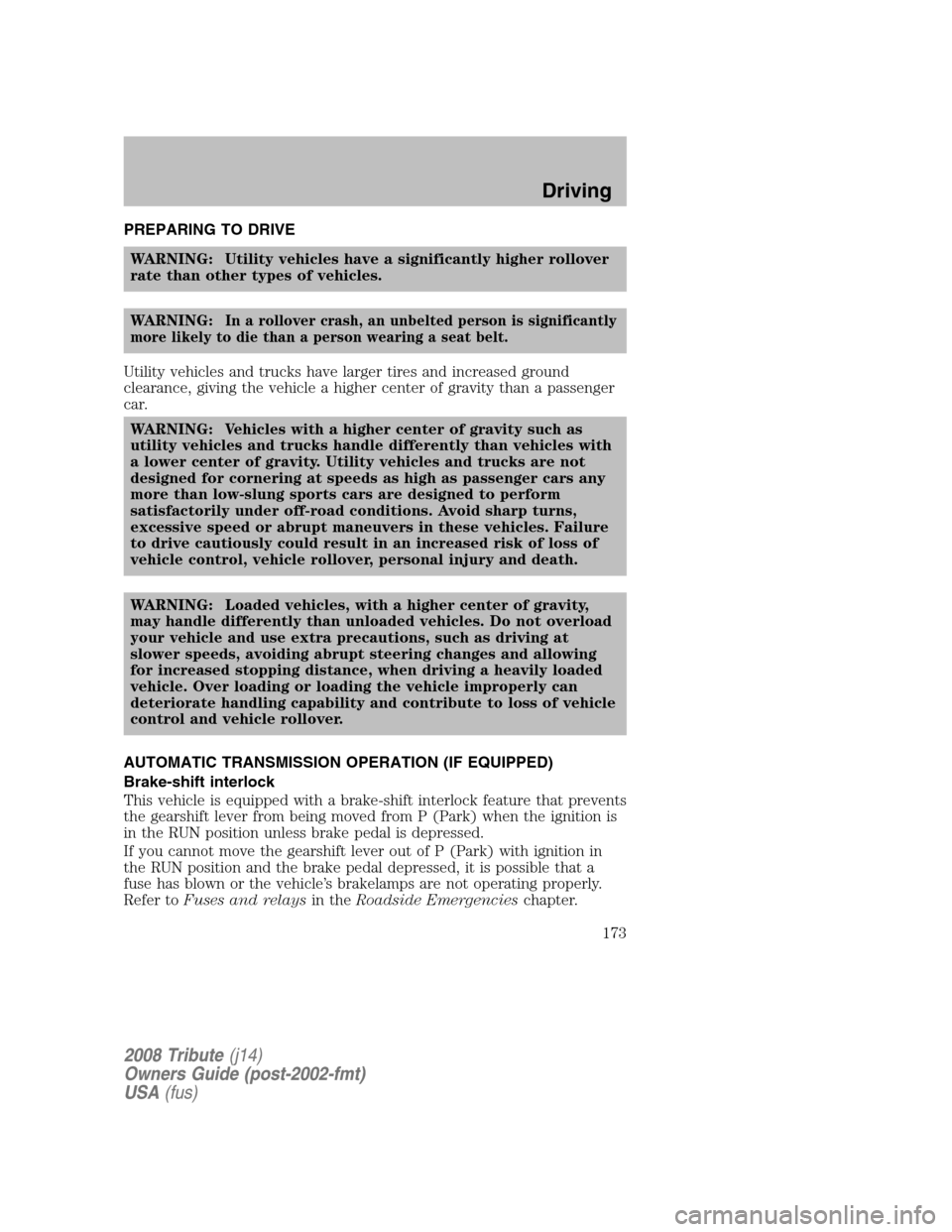
PREPARING TO DRIVE WARNING: Utility vehicles have a significantly higher rollover
rate than other types of vehicles.
WARNING:
In a rollover crash, an unbelted person is significantly
more likely to die than a person wearing a seat belt.
Utility vehicles and trucks have larger tires and increased ground
clearance, giving the vehicle a higher center of gravity than a passenger
car.
WARNING: Vehicles with a higher center of gravity such as
utility vehicles and trucks handle differently than vehicles with
a lower center of gravity. Utility vehicles and trucks are not
designed for cornering at speeds as high as passenger cars any
more than low-slung sports cars are designed to perform
satisfactorily under off-road conditions. Avoid sharp turns,
excessive speed or abrupt maneuvers in these vehicles. Failure
to drive cautiously could result in an increased risk of loss of
vehicle control, vehicle rollover, personal injury and death.
WARNING: Loaded vehicles, with a higher center of gravity,
may handle differently than unloaded vehicles. Do not overload
your vehicle and use extra precautions, such as driving at
slower speeds, avoiding abrupt steering changes and allowing
for increased stopping distance, when driving a heavily loaded
vehicle. Over loading or loading the vehicle improperly can
deteriorate handling capability and contribute to loss of vehicle
control and vehicle rollover.
AUTOMATIC TRANSMISSION OPERATION (IF EQUIPPED)
Brake-shift interlock
This vehicle is equipped with a brake-shift interlock feature that prevents
the gearshift lever from being moved from P (Park) when the ignition is
in the RUN position unless brake pedal is depressed.
If you cannot move the gearshift lever out of P (Park) with ignition in
the RUN position and the brake pedal depressed, it is possible that a
fuse has blown or the vehicle’s brakelamps are not operating properly.
Refer to Fuses and relays in theRoadside Emergencies chapter.
2008 Tribute(j14)
Owners Guide (post-2002-fmt)
USA (fus)
Driving
173
Page 174 of 288
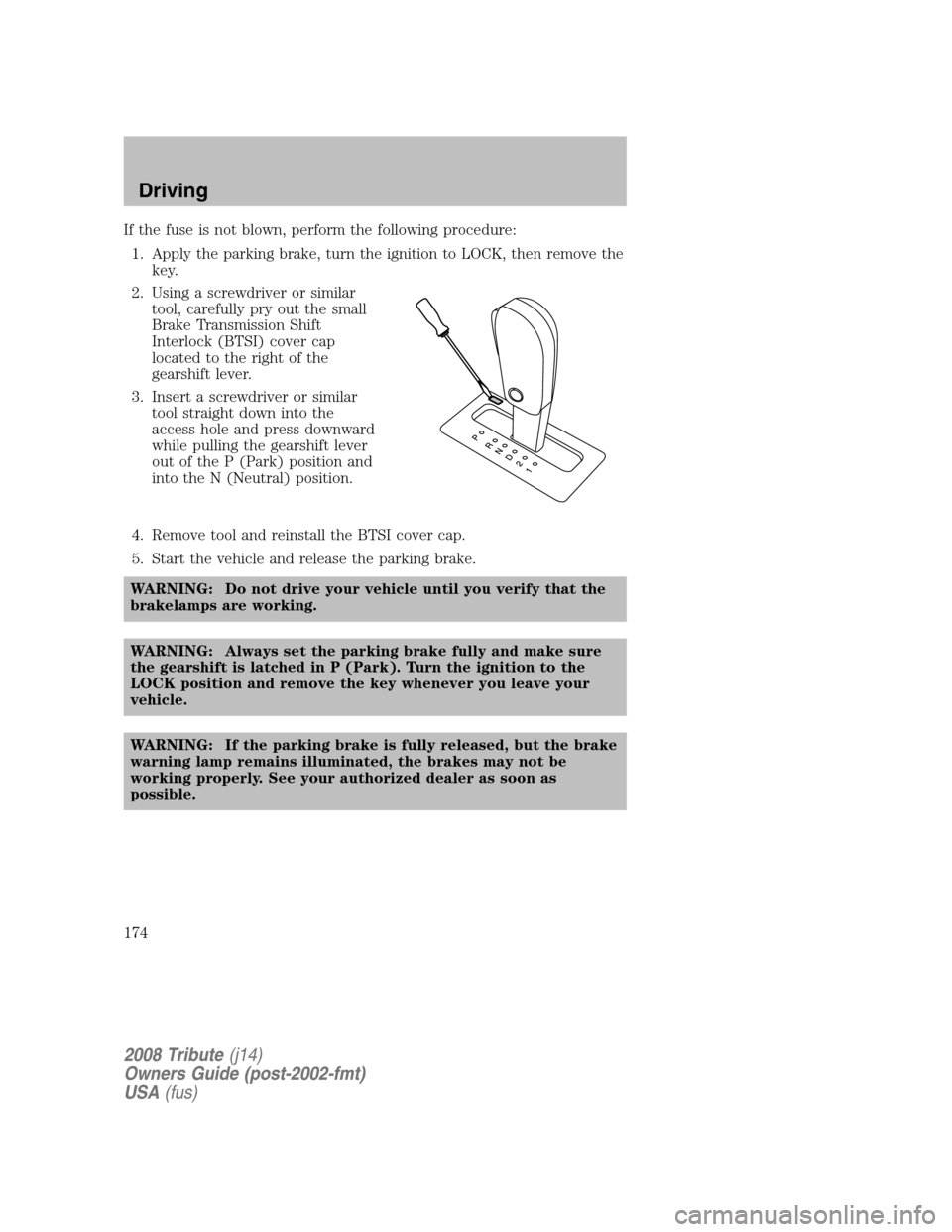
If the fuse is not blown, perform the following procedure: 1. Apply the parking brake, turn the ignition to LOCK, then remove the key.
2. Using a screwdriver or similar tool, carefully pry out the small
Brake Transmission Shift
Interlock (BTSI) cover cap
located to the right of the
gearshift lever.
3. Insert a screwdriver or similar tool straight down into the
access hole and press downward
while pulling the gearshift lever
out of the P (Park) position and
into the N (Neutral) position.
4. Remove tool and reinstall the BTSI cover cap.
5. Start the vehicle and release the parking brake.
WARNING: Do not drive your vehicle until you verify that the
brakelamps are working.
WARNING: Always set the parking brake fully and make sure
the gearshift is latched in P (Park). Turn the ignition to the
LOCK position and remove the key whenever you leave your
vehicle.
WARNING: If the parking brake is fully released, but the brake
warning lamp remains illuminated, the brakes may not be
working properly. See your authorized dealer as soon as
possible.
2008 Tribute (j14)
Owners Guide (post-2002-fmt)
USA (fus)
Driving
174
Page 175 of 288

Driving with an automatic overdrive transaxle
Your automatic overdrive transaxle
provides fully automatic operation in
either D (Overdrive) or with the
O/D OFF switch depressed. Driving
with the gearshift lever in
D (Overdrive) gives the best fuel
economy for normal driving
conditions.
For manual control, start in
1 (First) and then shift manually.
Understanding the gearshift positions of the 4–speed automatic
transaxle
2008 Tribute (j14)
Owners Guide (post-2002-fmt)
USA (fus)
Driving
175
Page 176 of 288
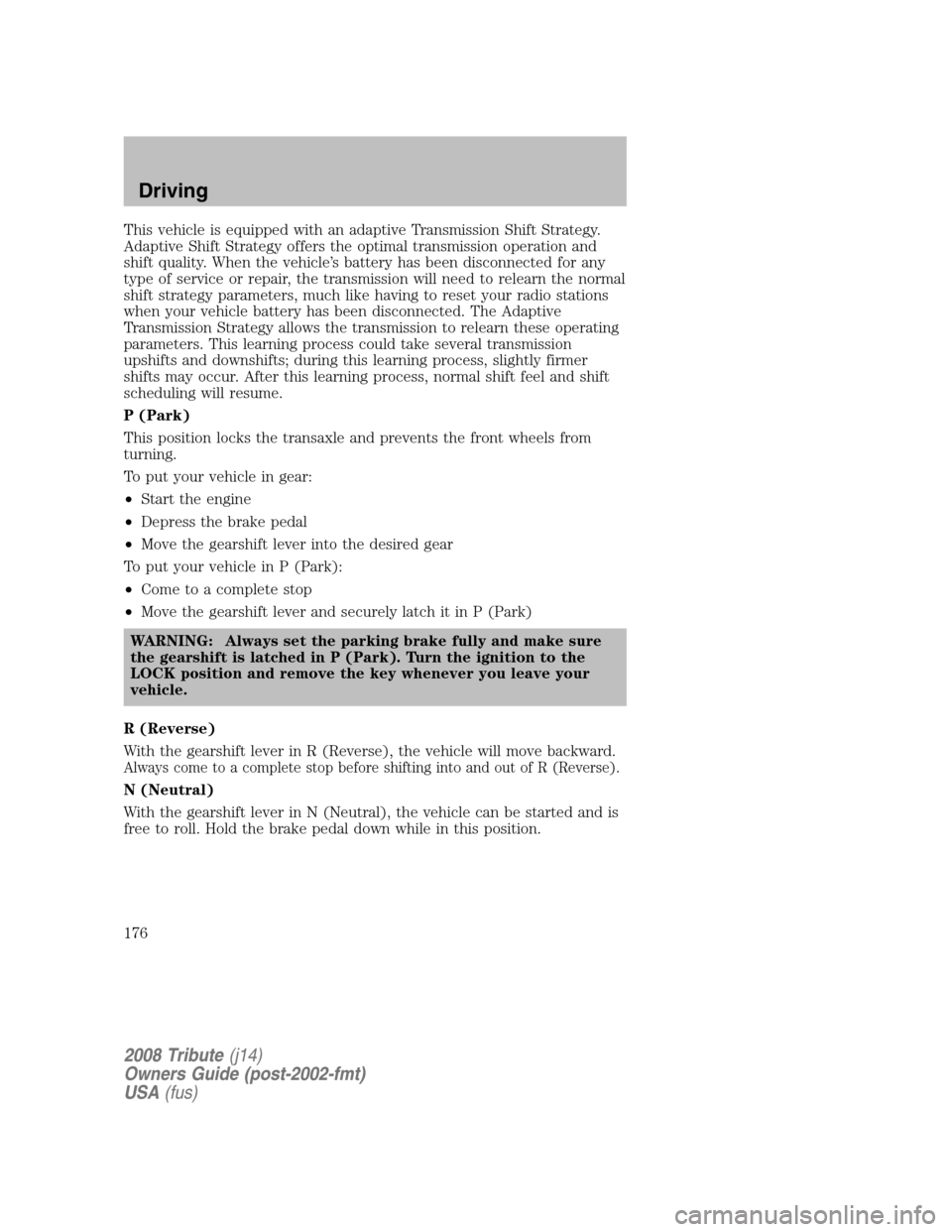
This vehicle is equipped with an adaptive Transmission Shift Strategy.
Adaptive Shift Strategy offers the optimal transmission operation and
shift quality. When the vehicle’s battery has been disconnected for any
type of service or repair, the transmission will need to relearn the normal
shift strategy parameters, much like having to reset your radio stations
when your vehicle battery has been disconnected. The Adaptive
Transmission Strategy allows the transmission to relearn these operating
parameters. This learning process could take several transmission
upshifts and downshifts; during this learning process, slightly firmer
shifts may occur. After this learning process, normal shift feel and shift
scheduling will resume.
P (Park)
This position locks the transaxle and prevents the front wheels from
turning.
To put your vehicle in gear:
• Start the engine
• Depress the brake pedal
• Move the gearshift lever into the desired gear
To put your vehicle in P (Park):
• Come to a complete stop
• Move the gearshift lever and securely latch it in P (Park)
WARNING: Always set the parking brake fully and make sure
the gearshift is latched in P (Park). Turn the ignition to the
LOCK position and remove the key whenever you leave your
vehicle.
R (Reverse)
With the gearshift lever in R (Reverse), the vehicle will move backward.
Always come to a complete stop before shifting into and out of R (Reverse).
N (Neutral)
With the gearshift lever in N (Neutral), the vehicle can be started and is
free to roll. Hold the brake pedal down while in this position.
2008 Tribute (j14)
Owners Guide (post-2002-fmt)
USA (fus)
Driving
176
Page 177 of 288

D (Overdrive)
The normal driving position for the
best fuel economy. Transaxle
operates in gears one through four.
D (Overdrive) can be deactivated by
pressing the O/D OFF switch on the
side of the gearshift lever. This will
illuminate the O/D OFF light and
activate Drive.
Drive (O/D OFF switch pressed)
Drive is activated when the O/D OFF switch is pressed.
• This position allows for all forward gears except overdrive.
• O/D OFF light is illuminated.
• Provides engine braking.
• Use when driving conditions cause excessive shifting from O/D to
other gears. Examples: city traffic, hilly terrain, heavy loads, trailer
towing and when engine braking is required.
• To return to O/D (overdrive mode), press the O/D OFF switch. The
O/D OFF light will not be illuminated.
• O/D (Overdrive) is automatically returned each time the key is turned
off.
2 (Second)
This position allows for second gear only.
• Provides engine braking.
• Use to start-up on slippery roads.
• To return to D (Overdrive), move the gearshift lever into the
D (Overdrive) position.
• Selecting 2 (Second) at higher speeds will cause the transaxle to
downshift to second gear at the appropriate vehicle speed.
2008 Tribute (j14)
Owners Guide (post-2002-fmt)
USA (fus)
Driving
177
Page 178 of 288

1 (First)
• Provides maximum engine braking.
• Allows upshifts by moving gearshift lever.
• Will not downshift into 1 (First) at high speeds; allows for 1 (First)
when vehicle reaches slower speeds.
WARNING: When parking, do not use the gearshift in place of
the parking brake. Always set the parking brake fully and make
sure that the gearshift is securely latched in P (Park). Turn off
the ignition whenever you leave your vehicle. Never leave your
vehicle unattended while it is running. If you do not take these
precautions, your vehicle may move unexpectedly and injure
someone.
Forced downshifts
• Allowed in D (Overdrive) or Drive.
• Depress the accelerator to the floor.
• Allows transmission to select an appropriate gear.
If your vehicle gets stuck in mud or snow
If your vehicle gets stuck in mud or snow, it may be rocked out by
shifting between forward and reverse gears, stopping between shifts in a
steady pattern. Press lightly on the accelerator in each gear.
Do not rock the vehicle if the engine is not at normal operating
temperature or damage to the transmission may occur.
Do not rock the vehicle for more than a minute or damage to the
transmission and tires may occur, or the engine may overheat.
2008 Tribute (j14)
Owners Guide (post-2002-fmt)
USA (fus)
Driving
178
Page 179 of 288

MANUAL TRANSMISSION OPERATION (IF EQUIPPED)
Using the clutch
The manual transaxle has a starter interlock that prevents cranking the
engine unless the clutch pedal is fully depressed.
To start the vehicle:1. Make sure the parking brake is fully set.
2. Press the clutch pedal to the floor, then put the gearshift lever in the neutral position.
3. Start the engine.
4. Press the brake pedal and move the gearshift lever to the desired gear; 1 (First) or R (Reverse).
5. Release the parking brake, then slowly release the clutch pedal while slowly pressing on the accelerator.
During each shift, the clutch pedal must be fully depressed to the floor.
Make sure the floor mat is properly positioned so it doesn’t interfere with
the full extension of the clutch pedal.
Failure to fully depress the clutch pedal to the floor may cause
increased shift efforts, prematurely wear transaxle components
or damage the transaxle.
Do not drive with your foot resting on the clutch pedal or use the
clutch pedal to hold your vehicle at a standstill while waiting on a
hill. These actions will reduce the life of the clutch.
1 35
24 R
2008 Tribute (j14)
Owners Guide (post-2002-fmt)
USA (fus)
Driving
179
Page 180 of 288
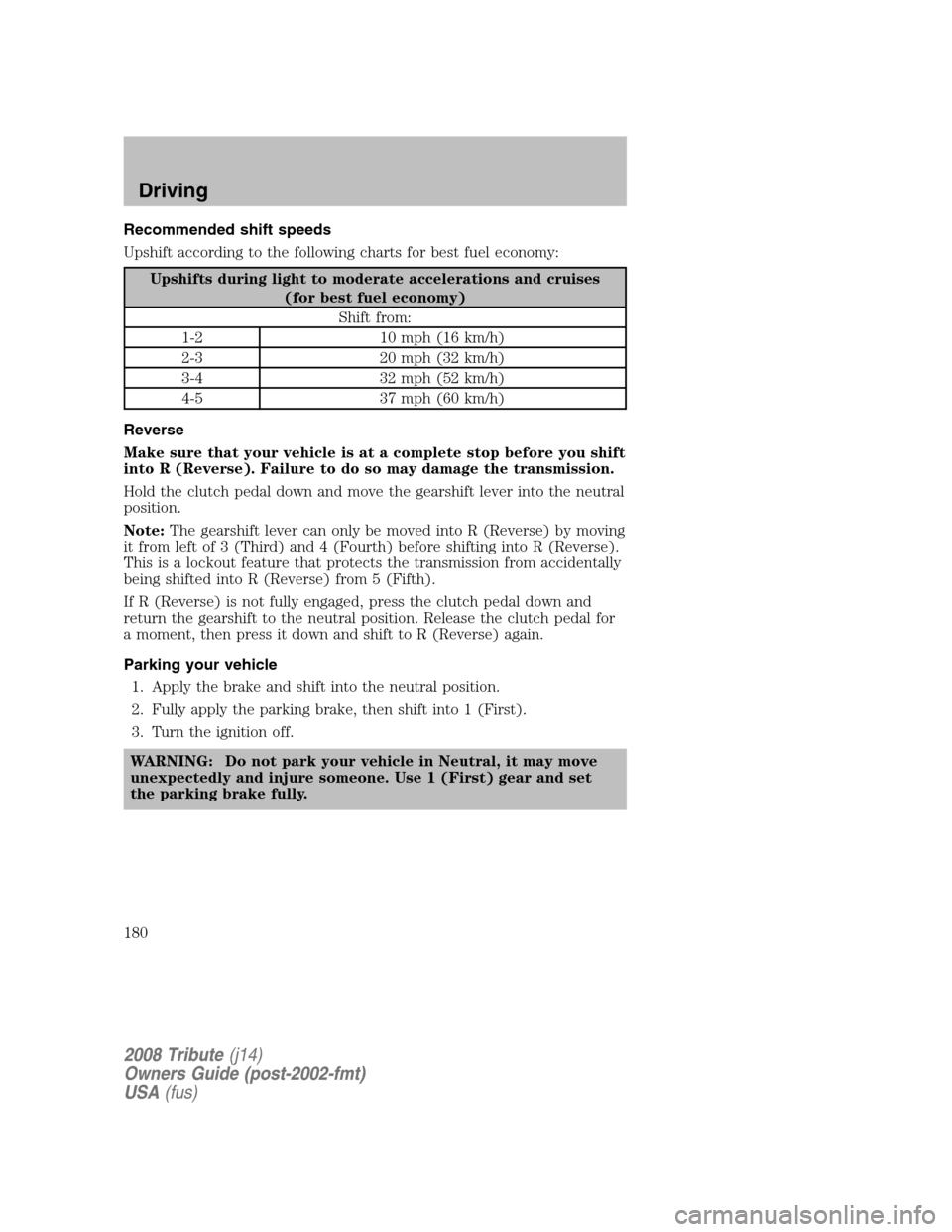
Recommended shift speeds
Upshift according to the following charts for best fuel economy:
Upshifts during light to moderate accelerations and cruises (for best fuel economy)
Shift from:
1-2 10 mph (16 km/h)
2-3 20 mph (32 km/h)
3-4 32 mph (52 km/h)
4-5 37 mph (60 km/h)
Reverse
Make sure that your vehicle is at a complete stop before you shift
into R (Reverse). Failure to do so may damage the transmission.
Hold the clutch pedal down and move the gearshift lever into the neutral
position.
Note: The gearshift lever can only be moved into R (Reverse) by moving
it from left of 3 (Third) and 4 (Fourth) before shifting into R (Reverse).
This is a lockout feature that protects the transmission from accidentally
being shifted into R (Reverse) from 5 (Fifth).
If R (Reverse) is not fully engaged, press the clutch pedal down and
return the gearshift to the neutral position. Release the clutch pedal for
a moment, then press it down and shift to R (Reverse) again.
Parking your vehicle
1. Apply the brake and shift into the neutral position.
2. Fully apply the parking brake, then shift into 1 (First).
3. Turn the ignition off.
WARNING: Do not park your vehicle in Neutral, it may move
unexpectedly and injure someone. Use 1 (First) gear and set
the parking brake fully.
2008 Tribute (j14)
Owners Guide (post-2002-fmt)
USA (fus)
Driving
180